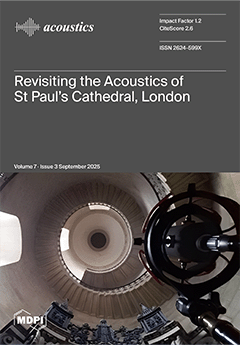The architecture of contemporary museums often emphasizes visual aesthetics, such as large volumes, open-plan layouts, and highly reflective finishes, resulting in acoustic challenges, such as excessive reverberation, poor speech intelligibility, elevated background noise, and reduced privacy. This study quantified the impact of surface—specific
[...] Read more.
The architecture of contemporary museums often emphasizes visual aesthetics, such as large volumes, open-plan layouts, and highly reflective finishes, resulting in acoustic challenges, such as excessive reverberation, poor speech intelligibility, elevated background noise, and reduced privacy. This study quantified the impact of surface—specific absorption treatments on acoustic metrics across eight gallery spaces. Room impulse responses calibrated virtual models, which simulated nine absorption scenarios (low, medium, and high on ceilings, floors, and walls) and evaluated reverberation time (T
20), speech transmission index (STI), clarity (C
50), distraction distance (r
D), Spatial Decay Rate of Speech (D
2,S), and Speech Level at 4 m (L
p,A,S,4m). The results indicate that going from concrete to a wooden floor yields the most rapid T
20 reductions (up to −1.75 s), ceiling treatments deliver the greatest STI and C
50 gains (e.g., STI increases of +0.16), and high-absorption walls maximize privacy metrics (D
2,S and L
p,A,S,4m). A linear regression model further predicted the STI from T
20, total absorption (Sabins), and room volume, with an 84.9% conditional R
2, enabling ±0.03 accuracy without specialized testing. These findings provide empirically derived, surface-specific “first-move” guidelines for architects and acousticians, underscoring the necessity of integrating acoustics early in museum design to balance auditory and visual objectives and enhance the visitor experience.
Full article





